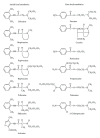Interaction of local anesthetics with biomembranes consisting of phospholipids and cholesterol: mechanistic and clinical implications for anesthetic and cardiotoxic effects
- PMID: 24174934
- PMCID: PMC3794646
- DOI: 10.1155/2013/297141
Interaction of local anesthetics with biomembranes consisting of phospholipids and cholesterol: mechanistic and clinical implications for anesthetic and cardiotoxic effects
Abstract
Despite a long history in medical and dental application, the molecular mechanism and precise site of action are still arguable for local anesthetics. Their effects are considered to be induced by acting on functional proteins, on membrane lipids, or on both. Local anesthetics primarily interact with sodium channels embedded in cell membranes to reduce the excitability of nerve cells and cardiomyocytes or produce a malfunction of the cardiovascular system. However, the membrane protein-interacting theory cannot explain all of the pharmacological and toxicological features of local anesthetics. The administered drug molecules must diffuse through the lipid barriers of nerve sheaths and penetrate into or across the lipid bilayers of cell membranes to reach the acting site on transmembrane proteins. Amphiphilic local anesthetics interact hydrophobically and electrostatically with lipid bilayers and modify their physicochemical property, with the direct inhibition of membrane functions, and with the resultant alteration of the membrane lipid environments surrounding transmembrane proteins and the subsequent protein conformational change, leading to the inhibition of channel functions. We review recent studies on the interaction of local anesthetics with biomembranes consisting of phospholipids and cholesterol. Understanding the membrane interactivity of local anesthetics would provide novel insights into their anesthetic and cardiotoxic effects.
Figures






Similar articles
-
Stereostructure-based differences in the interactions of cardiotoxic local anesthetics with cholesterol-containing biomimetic membranes.Bioorg Med Chem. 2011 Jun 1;19(11):3410-5. doi: 10.1016/j.bmc.2011.04.030. Epub 2011 Apr 22. Bioorg Med Chem. 2011. PMID: 21550810
-
Local anesthetics structure-dependently interact with anionic phospholipid membranes to modify the fluidity.Chem Biol Interact. 2010 Jan 5;183(1):19-24. doi: 10.1016/j.cbi.2009.10.006. Chem Biol Interact. 2010. PMID: 19853592
-
Membrane interactivity of charged local anesthetic derivative and stereoselectivity in membrane interaction of local anesthetic enantiomers.Local Reg Anesth. 2008;1:1-9. doi: 10.2147/lra.s3876. Epub 2008 Aug 6. Local Reg Anesth. 2008. PMID: 22915858 Free PMC article.
-
Biophysical studies on agents affecting the state of membrane lipids: biochemical and pharmacological implications.Mol Cell Biochem. 1978 Nov 30;22(1):3-32. doi: 10.1007/BF00241467. Mol Cell Biochem. 1978. PMID: 154058 Review.
-
Molecular details of anesthetic-lipid interaction.Ann N Y Acad Sci. 1991;625:668-84. doi: 10.1111/j.1749-6632.1991.tb33901.x. Ann N Y Acad Sci. 1991. PMID: 2058915 Review.
Cited by
-
SARS-CoV-2 requires cholesterol for viral entry and pathological syncytia formation.Elife. 2021 Apr 23;10:e65962. doi: 10.7554/eLife.65962. Elife. 2021. PMID: 33890572 Free PMC article.
-
Water in the human body: An anesthesiologist's perspective on the connection between physicochemical properties of water and physiologic relevance.Ann Med Surg (Lond). 2017 Dec 27;26:1-8. doi: 10.1016/j.amsu.2017.12.007. eCollection 2018 Feb. Ann Med Surg (Lond). 2017. PMID: 29904607 Free PMC article. Review.
-
Racemization in Post-Translational Modifications Relevance to Protein Aging, Aggregation and Neurodegeneration: Tip of the Iceberg.Symmetry (Basel). 2021 Mar;13(3):455. doi: 10.3390/sym13030455. Epub 2021 Mar 11. Symmetry (Basel). 2021. PMID: 34350031 Free PMC article.
-
Quantitative Analysis of the Membrane Affinity of Local Anesthetics Using a Model Cell Membrane.Membranes (Basel). 2021 Jul 30;11(8):579. doi: 10.3390/membranes11080579. Membranes (Basel). 2021. PMID: 34436342 Free PMC article.
-
ProcCluster® and procaine hydrochloride inhibit the replication of influenza A virus in vitro.Front Microbiol. 2024 Aug 14;15:1422651. doi: 10.3389/fmicb.2024.1422651. eCollection 2024. Front Microbiol. 2024. PMID: 39206370 Free PMC article.
References
-
- Strichartz GR, Sanchez V, Arthur GR, Chafetz R, Martin D. Fundamental properties of local anesthetics. II. Measured octanol: buffer partition coefficients and pKa values of clinically used drugs. Anesthesia and Analgesia. 1990;71(2):158–170. - PubMed
-
- López AB, Diago MP. Failure of locoregional anesthesia in dental practice. Review of the literature. Medicina Oral, Patología Oral y Cirugía Bucal. 2006;11(6):E510–E513. - PubMed
-
- Tan JHC, Saint DA. Interaction of lidocaine with the cardiac sodium channel. Effects of low extracellular pH are consistent with an external blocking site. Life Sciences. 2000;67(22):2759–2766. - PubMed
-
- Yanagidate F, Strichartz GR. Handbook of Experimental Pharmacology. Vol. 177. Berlin, Germany: Springer; 2007. Local anesthetics; pp. 95–127. - PubMed
Publication types
LinkOut - more resources
Full Text Sources
Other Literature Sources

